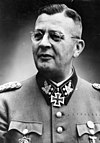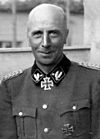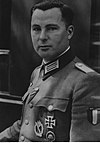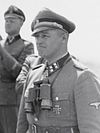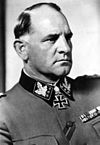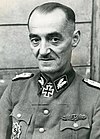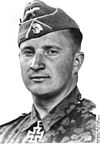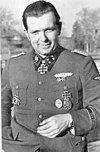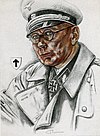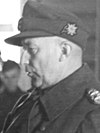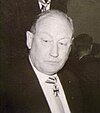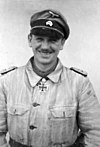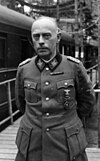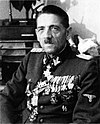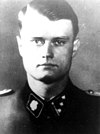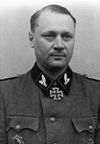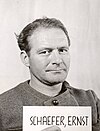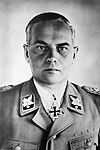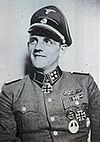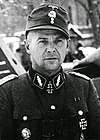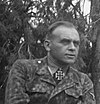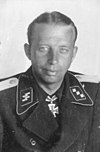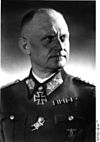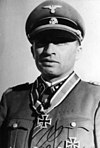| Knight's Cross recipients | |
|---|---|
 | |
| All grades | Grand Cross Golden Oak Leaves, Swords and Diamonds Oak Leaves, Swords and Diamonds Oak Leaves and Swords |
| Oak Leaves | |
| Knight's Cross | |
The Knight's Cross of the Iron Cross (German: Ritterkreuz des Eisernen Kreuzes) and its variants were the highest award in the military and paramilitary forces of Nazi Germany. During World War II, 457 servicemen of the Waffen-SS, including volunteers and conscripts from Belgium, Croatia, Denmark, Estonia, France, Hungary, Latvia, Netherlands and Norway, received the Knight's Cross of the Iron Cross. Of these, 411 presentations were formally made and evidence of the award is available in the German Federal Archives. One recipient, Hermann Fegelein, was court-martialed and executed on 29 April 1945. According to German law he was deprived of rank and all awards previously. Fegelein must therefore be considered a de facto but not de jure recipient. A further 46 Knight's Cross, 8 Knight's Cross with Oak Leaves and 4 Knight's Cross with Oak Leaves and Swords recipients are either lacking the evidence to sustain their listings or received the award under questionable legal terms. All of them were accepted by the Association of Knight's Cross Recipients (Ordensgemeinschaft der Ritterkreuzträger des Eisernen Kreuzes e.V.) as legitimate recipients.
The Oberkommando der Wehrmacht kept separate Knight's Cross lists, one for each of the three military branches, Heer (Army), Kriegsmarine (Navy), Luftwaffe (Air force) and for the Waffen-SS. Within each of these lists, a unique sequential number was assigned to each recipient. The same numbering paradigm was applied to the higher grades of the Knight's Cross, one list per grade.
Background
The Knight's Cross of the Iron Cross and its higher grades were based on four separate enactments. The first enactment, Reichsgesetzblatt I S. 1573 of 1 September 1939 instituted the Iron Cross (Eisernes Kreuz), the Knight's Cross of the Iron Cross and the Grand Cross of the Iron Cross (Großkreuz des Eisernen Kreuzes). Article 2 of the enactment mandated that the award of a higher class be preceded by the award of all preceding classes. As the war progressed, some of the recipients of the Knight's Cross distinguished themselves further and a higher grade, the Oak Leaves to the Knight's Cross of the Iron Cross, was instituted. The Oak Leaves, as they were commonly referred to, were based on the enactment Reichsgesetzblatt I S. 849 of 3 June 1940. In 1941, two higher grades of the Knight's Cross were instituted. The enactment Reichsgesetzblatt I S. 613 of 28 September 1941 introduced the Knight's Cross of the Iron Cross with Oak Leaves and Swords and the Knight's Cross of the Iron Cross with Oak Leaves, Swords and Diamonds. At the end of 1944 the final grade, the Knight's Cross of the Iron Cross with Golden Oak Leaves, Swords, and Diamonds, based on the enactment Reichsgesetzblatt 1945 I S. 11 of 29 December 1944, became the final variant of the Knight's Cross authorized.
Recipients
The list is initially sorted alphabetically.
This along with the * (asterisk) indicates that the Knight's Cross was awarded posthumously.
This along with the ? (question mark) indicates that author Veit Scherzer has expressed doubt regarding the veracity and formal correctness of the listing.
Notes
- Adolf Ax's nomination shows no indication that the request had been processed or granted, not even an entry date is noted. The nomination list indicates that the request was filed on the 28 April 1945. A Heerespersonalamt (HPA—Army Staff Office) nomination with the number 5092 had been created. The nomination, according to the book "Verliehene Ritterkreuze" (Awarded Knight Crosses), was forwarded to the HPA on 25 April 1945. No proof exists that the Knight's Cross was awarded. The Order Commission of the Association of Knight's Cross Recipients (AKCR) processed this case in 1981 and decided: Knight's Cross yes, 9 May 1945. Ax was a member of the AKCR.
- No evidence of the award can be found in the German Federal Archives. The award was unlawfully presented by SS-Oberstgruppenführer Sepp Dietrich. The date is taken from the announcement made by the 6. SS-Panzerarmee. Bastian was a member of the Association of Knight's Cross Recipients (AKCR).
- No evidence of the award can be found in the German Federal Archives. The award was unlawfully presented by SS-Oberstgruppenführer Sepp Dietrich. The date is taken from the announcement made by the 6. SS-Panzerarmee. The sequential number "153" was assigned by the Association of Knight's Cross Recipients (AKCR). Bittrich was member of the AKCR.
- No evidence of the award can be found in the German Federal Archives. According to Krätschmer the award was presented together with the Oak Leaves to Matthias Kleinheisterkamp. Presumably the announcement was made via radio transmission on 28 April 1945 from the Führer Headquarters in Berlin to the 9. Armee (9th Army) in the Halbe pocket. The radio transmissions received by the AOK 9 (Armeeoberkommando 9 — high command of the 9th army) in April 1945 were not retained. All communication to the Führerbunker in Berlin were out of order as of 5AM on 28 April. The order commission of the Association of Knight's Cross Recipients (AKCR) processed the case in 1981 and decided: "Knight's Cross yes, 28 April 1945", Friedrich Blond was a member of the AKCR.
- No evidence of the award to Karl-Heinz Bühler can be found in the German Federal Archives. The award was presumably awarded by SS-Oberstgruppenführer Sepp Dietrich, which would make it an unlawful presentation. The Order Commission of the Association of Knight's Cross Recipients (AKCR) processed this case in 1977 and decided: Knight's Cross no, 1 May 1945. The case Bühler was again processed in the fall of 1983. Whether or not additional or new evidence materialized remains unknown. The Order Commission decided this time: Knight's Cross yes, 8 May 1945. Von Seemen lists him on 7 May 1945, Krätschmer states 1 May 1945. Fellgiebel later re-dated the award on the 6 May 1945. It remains subject to speculation why this was done. Bühler was a member of the AKCR.
- No evidence of the award can be found in the German Federal Archives. The award was unlawfully presented by SS-Oberstgruppenführer Sepp Dietrich. The date is taken from the announcement made by the 6. SS-Panzerarmee. Draxenberger was a member of the Association of Knight's Cross Recipients (AKCR).
- No evidence of the award can be found in the German Federal Archives. The award was unlawfully presented by SS-Oberstgruppenführer Sepp Dietrich. The date is taken from the announcement made by the 6. SS-Panzerarmee. Franz Josef Dreike was a member of the Association of Knight's Cross Recipients (AKCR).
- No evidence of the award can be found in the German Federal Archives. Presumably the award was presented by SS-Oberstgruppenführer Sepp Dietrich which would make it an unlawful presentation. The date was assumed by Fellgiebel. Von Seemen states the 23 November 1944. The author was denied access to files, which could help clarify the case, of the Association of Knight's Cross Recipients (AKCR) on the grounds of the Bundesarchivgesetz (German Archive Law). Oskar Drexler was a member of the AKCR.
- No evidence of the award can be found in the German Federal Archives. The author was denied access to files, which could help clarify the case, of the Association of Knight's Cross Recipients (AKCR) on the grounds of the Bundesarchivgesetz (German Archive Law). Paul Egger was a member of the AKCR.
- Hermann Fegelein was sentenced to death by Hitler and executed by SS General Johann Rattenhuber's RSD on 28 April 1945 after a court martial led by 18SS-Brigadeführer and Generalmajor of the Waffen-SS Wilhelm Mohnke. The sentence was carried out the same day. The death sentence resulted in the loss of all orders and honorary signs.
- A lawful presentation via the chain of command to the chief of the Heerespersonalamt (HPA—Army Staff Office) Wilhelm Burgdorf in Berlin submitted nomination is possible. Also possible is a direct presentation by Adolf Hitler. However no evidence of the award can be found in the German Federal Archives. The author was denied access to files, which could help clarify the case, of the Association of Knight's Cross Recipients (AKCR) on the grounds of the Bundesarchivgesetz (German Archive Law). Fellgiebel wrote in a letter dated 31 August 1976: "...He (Willhelm Fey) after joining the Bundeswehr has request a court of honor against himself. Chairman was our companion recipient of the Oak Leaves former Oberst XXXX (name was made anonymous). This court of honor has accepted him without evidence". The order commission of the AKCR accepted this. Fellgiebel wrote: "...we don't want to claim that we are smarter than the Bundeswehr." Willhelm Fey was a member of the AKCR.
- Alfred Fischer's nomination, according to a file card, was received by the Heerespersonalamt (HPA—Army Staff Office) on 11 January 1945. The nomination, according to the book "Verliehene Ritterkreuze" (Awarded Knight Crosses) and note on the file card, had been rejected without specifying a date. A HPA nomination was not created. Fischer received the Honour Roll Clasp of the Army on 5 March 1945 which may have result of the rejected Knight's Cross nomination. The nomination by the troop is missing, which may be an indication that it had been forwarded to the Referat Vg (responsible for the Honour Roll Clasp listings). The presentation date is an assumption of the Association of Knight's Cross Recipients (AKCR). Krätschmer states the 9 May 1945.
- No evidence of the award can be found in the German Federal Archives. Presumably the award was presented by SS-Oberstgruppenführer Sepp Dietrich which would make it an unlawful presentation. The date 6 May 1945 was assumed by Fellgiebel. Von Seemen states the 3 May 1945. Kurt Fröhlich is not mentioned in Krätschmer's book. The author was denied access to files, which could help clarify the case, of the Association of Knight's Cross Recipients (AKCR) on the grounds of the Bundesarchivgesetz (German Archive Law).
- Roberts Gaigals' nomination had been finalized by the Heerespersonalamt (HPA—Army Staff Office) and was ready for signature by the end of the war. According to the Association of Knight's Cross Recipients (AKCR) the award was presented in accordance with the Dönitz-decree. This is illegal according to the Deutsche Dienststelle (WASt) and lacks legal justification. The presentation date is an assumption of the AKCR.
- No evidence regarding the presentation of the Knight's Cross of the Iron Cross to Karl Gebhard can be found in the German Federal Archive. Fellgiebel also had no evidence and wrote on 11 July 1983 to Mr. Eichhorn: "I have to rely on Krätschmer in Rieflin Fritz's case, as well as in Gebhard's.". Krätschmer may have his information from Hermann Buch, the former IIa (personnel administration) of the 2. SS-Division "Das Reich", who mentioned the name Gebhard in a letter to von Seeman on 6 December 1970. Unlawful presentation by SS-Oberstgruppenführer Sepp Dietrich. The date is taken from the announcement made by the 6. SS-Panzerarmee.
- Karl-Heinz Gieseler is listed as a recipient in Fellgiebel as SS-Untersturmführer and Stoßtruppführer in Berlin as a member of the 11. SS-Panzergrenadier-Division "Nordland". Fellgiebel himself states that the presentation was made by SS-Brigadeführer Wilhelm Mohnke in the bunker of the Reichs Chancellery between 25 – 30 April 1945. The number of likely presentations varies between 3 and 5 soldiers. No evidence of the award can be found in the German Federal Archives. Gieseler is not listed by Scherzer.
- No evidence of the award can be found in the German Federal Archives. According to Krätschmer the action took place in March 1945 in Pomerania with the Army Group Vistula. Von Seemen lists Herbert Golz with the footnote: "Source: Generalmajor (Pol.) Rode, at the time chief of staff with the chief of the German Police". This posting is not verifiable. A SS-Brigadeführer and Generalmajor Rode is verifiable and was chief of staff of the field commando of the Reichsführer SS. This field commando processed at the time the nominations of the Waffen-SS and prepared them for approval by Heinrich Himmler. These nominations at the time were received by SS-Obersturmbannführer Kment, the adjutant of Himmler and liaison officer to the Heerespersonalamt (HPA—Army Staff Office). Golz nomination could have been a unlawful presentation by Himmler as commander in chief of the Army Group Vistula. The order commission of the Association of Knight's Cross Recipients (AKCR) handled this case in 1977 and decided: "Knight's Cross yes, 31 March 1945". The evidence sustaining this decision remains unclear. Access to the files was denied on the grounds of the Bundesarchivgesetz (German Archive Law). The presentation date was later changed by Fellgiebel. Golz was a member of the AKCR.
- No evidence of the award can be found in the German Federal Archives. According to Fellgiebel the award was presented by SS-Oberstgruppenführer Sepp Dietrich, which would make it an unlawful presentation. Fellgiebel's sources are Hermann Buch and Wilhelm Kment. According to Buch—note from 25 June 2005—he has nothing to do with this presentation. And Kment cannot be the source, since Buch stated that Kment died in the early 1970s (Wilhelm Kment actually died on 15 November 1984). If Kment were the source then von Seemen would have listed Heinz Gropp in either the first or second edition of his book, which is not the case. The source thus remains uncertain. Krätschmer lists Gropp in his third edition with a date of 1 May 1945 without stating a source as well. Fellgiebel dated the award on 6 May 1945. He may have done this to justify this as a Dietrich award.
- The recommendation for Franz Hack's Oak Leaves to the Knight's Cross was submitted to the Heerespersonalamt (HPA—Army Staff Office) by the Division sometime between 16 and 19 April 1945 and approved by the commander of the IV. SS-Korps Herbert Otto Gille. Missing is the approval from the 6. Armee and Heeresgruppe Süd. There is no indication whether the recommendation was approved. The response from the Reichsführer-SS was prepared but missing is a date and signature. The existing card is not contemporary. There is no indication in the press that the award was presented. According to Fellgiebel Hack received the Oak Leaves from SS-Obergruppenführer and General of the SS Herbert-Otto Gille, commanding general IV. SS-Panzerkorps. The sequential number "844" and date of award were assigned by the Association of Knight's Cross Recipients (AKCR).
- No evidence of the award can be found in the German Federal Archives. Presumably Desiderius Hampel received the Knight's Cross the same day as Karl Liecke and Hans Hanke. Letter from Krätschmer to von Seemen dated 7 August 1980. According to von Semen presumably presented by General Maximilian de Angelis. The Order Commission of the Association of Knight's Cross Recipients (AKCR) processed Hampel's case in 1980 and Fellgiebel decided: Knight's Cross yes, 3 May 1945. In his book he noted: "A justification for the presentation was not given". Hampel was a member of the AKCR.
- No evidence of the award can be found in the German Federal Archives. Hans Hanke, according to Krätschmer, was informed of the award by SS-Brigadeführer Desiderius Hampel and SS-Obersturmbannführer Karl Liecke. Both Hampel and Liecke supposedly received the Knight's Cross the same day—Letter from Krätschmer to von Seemen dated 7 August 1980. Mr Meentz of the German Federal Archive stated on 20 July 2004 that it cannot be verified that Hanke received the Knight's Cross. According to von Seemen the Knight's Cross was awarded by General Maximilian de Angelis. The order commission of the Association of Knight's Cross Recipients (AKCR) processed the case in 1980 and Fellgiebel decided: "Knight's Cross yes, 3 May 1945". Nevertheless Fellgiebel noted: No justification for the award.
- No evidence of the award can be found in the German Federal Archives. According to Krätschmer—letter dated on 7 August 1980 to von Seemen— the presentation was made in conjunction to the Oak Leaves presentation to Matthias Kleinheisterkamp and was announced via radio transmission on 28 April 1945 from the Führer Headquarters in Berlin to the 9. Armee (9th Army) in the Halbe pocket. The radio transmissions received by the AOK 9 (Armeeoberkommando 9 — high command of the 9th army) in April 1945 were not retained. All communication to the Führerbunker in Berlin were out of order as of 5AM on 28 April. The order commission of the Association of Knight's Cross Recipients (AKCR) processed Kurt Hartrampf's case in 1980 and decided solely relying on the letter from Krätschmer: "Knight's Cross yes, 28 April 1945", Hartrampf was a member of the AKCR.
- No evidence of the award can be found in the German Federal Archives. According to Krätschmer—letter dated on 7 August 1980 to von Seemen— the presentation was made in conjunction to the Oak Leaves presentation to Matthias Kleinheisterkamp and was announced via radio transmission on 28 April 1945 from the Führer Headquarters in Berlin to the 9. Armee (9th Army) in the Halbe pocket. The radio transmissions received by the AOK 9 (Armeeoberkommando 9 — high command of the 9th army) in April 1945 were not retained. All communication to the Führerbunker in Berlin were out of order as of 5AM on 28 April. The order commission of the Association of Knight's Cross Recipients (AKCR) processed Edgar Hauckelt's case in 1980 and decided solely relying on the letter from Krätschmer: "Knight's Cross yes, 28 April 1945".
- No evidence of the award can be found in the German Federal Archives. The award was unlawfully presented by SS-Oberstgruppenführer Sepp Dietrich. The date is taken from the announcement made by the 6. SS-Panzerarmee. Hauser was a member of the Association of Knight's Cross Recipients (AKCR).
- The nomination by the troop was received by the Heerespersonalamt (HPA—Army Staff Office) via teleprinter on 6 April 1945. This can be verified in the book "Verliehene Ritterkreuze" (Awarded Knight Crosses) and file card. A HPA nomination was never created or was not retained and according to the file card the nomination was numbered Nr. 5023 and forwarded for further processing. The file card indicates no further information. The presentation date according to Krätschmer was the 6 May 1945. Mr Meentz of the German Federal Archive stated on 20 July 2004 that it cannot be verified that Hans Havik (Johann Havik according to Scherzer) received the Knight's Cross. The presentation date 9 May 1945 was assigned by Fellgiebel.
- Mr Meentz of the German Federal Archive stated on 20 July 2004 that it cannot be verified that Ludwig Hoffmann received the Knight's Cross. The presentation date was assigned by Fellgiebel. Krätschmer lists him on 9 May 1945. Hoffmann was a member of the Association of Knight's Cross Recipients (AKCR)
- According to Scherzer on 20 April 1945
- Heinz Jürgens' nomination by the troop was received by the Heerespersonalamt (HPA—Army Staff Office) sometime between 23 and 27 April 1945 and prepared for signature with a presentation date of 28 April 1945. However it was never signed. According to the Association of Knight's Cross Recipients (AKCR) the award was presented in accordance with the Dönitz-decree. This is illegal according to the Deutsche Dienststelle (WASt) and lacks legal justification. Jürgens was a member of the AKCR.
- No evidence of the award can be found in the German Federal Archives. Fellgiebel claimed that Paul-Albert Kausch, at the time wounded in the Reich Chancellery, had received news that according to a radio message received from Panzer AOK 11 had been awarded the Oak Leaves on 23 April 1945 from SS-Brigadeführer Joachim Ziegler. Ziegler, the Division commander of Kausch, was killed in action on 1 May 1945. Krätschmer however indicated that Kausch was wounded 25 April, therefore he couldn’t have received the news on the 25 April. The 11th SS Volunteer Panzergrenadier Division Nordland was only subordinated to the 11th Panzer Armee in February 1945. The Stab of the 11th Panzer Army then relocated to the Western Front where it surrendered on 21 April. Krätschmer claimed that the award was presented for the actions during the middle of April east of Berlin. Mr. J.S. Fischer, who was verifying the Oak Leaves presentation on behalf of Fellgiebel is not aware of a radio message received from the Panzer AOK 11. Fischer indicated that he only referenced the information presented by Kausch, which is already stated in Krätschmer. According to information by Fischer on 14 October 2004, Fellgiebel had made the note about the Panzer AOK 11. The sequential number "845" was assigned by the Association of Knight's Cross Recipients (AKCR), according to Krätschmer the number is "846", the date was accepted by the AKCR. Kausch was member of the AKCR.
- No evidence of the award can be found in the German Federal Archives. Also never processed by the Order Commission of the Association of Knight's Cross Recipients (AKCR). According to von Semen presumably presented by General Maximilian de Angelis on the basis of the Dönitz-decree. Fellgiebel noted in his book: "A justification for the presentation was not given".
- Fellgiebel claims that the nomination was received by the Heerespersonalamt (HPA—Army Staff Office) via teleprinter from the commander-in-chief of the 9. Armee, general Theodor Busse, on 21 April 1945. Busse had nominated SS-Obergruppenführer Kleinheisterkamp for the Oak Leaves. The claim is that the teleprinter contained a note that the formal procedure for immediate approval should be waited for (Dienstwegvorschlag bzgl. Sofortverleihung abwarten). This teleprinter message cannot be found in the German Nation Archives (Bestand RH 7). Busse had also nominated by teleprinter Generalmajor Joachim von Siegroth on the 21 April. This teleprinter message can be found in the Nation Archives (Bundesarchiv RH 7/300). According to Fellgiebel the same note can be found on von Siegroth's nomination. This means that a formal nomination, in this instance via the Army Group Vistula, followed. Both announced "formal nominations" never followed and were never received by the HPA. The teleprinter nomination of von Siegroth is listed in the book of "awarded Knight Crosses" with an entry date of 21 April but Kleinheisterkamp's nomination isn't. The reason for this may be that the liaison officer of the Waffen-SS at the HPA/P5a may have forwarded the nomination to the Reichsführer-SS for approval. From here it should have been returned to the HPA which it wasn't. The distribution list of von Siegroth's nomination indicates that general Busse had informed the Army Group Vistula and the chief of the HPA general Wilhelm Burgdorf. It is very likely that Kleinheisterkamp's nomination had the same distribution list as von Siegroth's, because the same principles applied. Burgdorf therefore should have been informed of the formal procedure regarding Kleinheisterkamp's nomination. The question remains unanswered whether the Führer Headquarter or Adolf Hitler has approved the direct nomination of Kleinheisterkamp on 28 April or not. Scherzer claims that this is very unlikely because Burgdorf would not have done two things. First, submit a nomination to the Führer without having assessed the situation himself, which only would have been possible if he had studied the formal paperwork. Secondly he would not have bypassed the formal procedure which was already initiated. Additionally the radio connection to the Führerbunker was down since 5:00 on 28 April 1945. The sequential number "871" was assigned by the Association of Knight's Cross Recipients (AKCR) and the date is assumed.
- According to Fellgiebel on 2 May 1945 in the Battle of Halbe.
- No evidence of the award can be found in the German Federal Archives. The award was unlawfully presented by SS-Oberstgruppenführer Sepp Dietrich. The date is taken from the announcement made by the 6. SS-Panzerarmee.
- Walter Körner's nomination by the troop was received by the Heerespersonalamt (HPA—Army Staff Office) end of March 1945. There is no entry date listed on the file card nor in the book "Verliehene Ritterkreuze" (Awarded Knight Crosses). The HPA created a nomination request with the number 4980, which does not exist anymore, and according to the file card was submitted for further processing on 4 April 1945. No further comments or notes indicate that the nomination was finalized. Mr Meentz of the German Federal Archive stated on 20 July 2004 that it cannot be verified that Körner received the Knight's Cross. Fellgiebel assigned the presentation date. Krätschmer claims that the award was approved on 9 May 1945.
- Walter Krüger's date of death is inconclusive. According to Florian Berger date of death is 20 May 1945, Walther-Per Fellgiebel states 8 May 1945 and Veit Scherzer presents the 22 May 1945.
- No evidence of the award can be found in the German Federal Archives. The award was unlawfully presented by SS-Oberstgruppenführer Sepp Dietrich. The date is taken from the announcement made by the 6. SS-Panzerarmee.
- No evidence of the award can be found in the German Federal Archives. The award was unlawfully presented by SS-Oberstgruppenführer Sepp Dietrich. The date is taken from the announcement made by the 6. SS-Panzerarmee. The sequential number "862" was assigned by the Association of Knight's Cross Recipients (AKCR). Lehmann was member of the AKCR.
- No evidence regarding Jacques Leroy's nomination can be found in the German Federal Archive. A presentation, as assumed by Fellgiebel, by the chief of the Heerespersonalamt (HPA—Army Staff Office) Wilhelm Burgdorf, is very unlikely because the 28th SS Volunteer Grenadier Division Wallonien was deployed in Pomerania with the Army Group Vistula in March/April 1945 and not in or near Berlin. The author was denied access to files, which could help clarify the case, of the Association of Knight's Cross Recipients (AKCR) on the grounds of the Bundesarchivgesetz (German Archive Law). The presentation, according to Krätschmer, was confirmed by the former adjutant to the divisional commander in 1957 and divisional commander in 1973. Fellgiebel himself, in a letter dated 31 August 1976, considered this evidence as Quatsch (a hoke or nuts). Leroy was a member of the AKCR.
- No evidence of the award can be found in the German Federal Archives. According to Fellgiebel the Knight's Cross was presented by SS-Oberstgruppenführer Sepp Dietrich, which would make it an unlawful presentation. Fellgiebel states the sources Hermann Buch and Wilhelm Kment. Buch had nothing to do with this presentation (note from 25 June 2004). The 5th SS Panzer Division Wiking was not under the command of Dietrich in the respective timeframe. Krätschmer presents a presentation date of 25 March 1945 and von Seemen the 25 April 1945. Fellgiebel has changed this to the 6 May 1945. It has to be speculated whether Fellgiebel did this to hide the presentation among the Dietrich awards. Unfortunately Karl-Heinz Lichte, member of the Association of Knight's Cross Recipients (AKCR), did nothing to help clarify the situation. Two letters from the general manager of the AKCR had been sent to Lichte, the first on 24 July 2004 and the second on 22 August 2004.
- No evidence of the award can be found in the German Federal Archives. Presumably the Knight's Cross was awarded on the same day as Desiderius Hampel's and Hans Hanke's, as stated in a letter from Krätschmer to von Seemen dated 7 August 1980. According to von Seemen the award was presented by General Maximilian de Angelis. Fellgiebel accepted Karl Liecke as Knight's Cross recipient but noted in his book: "A justification for the presentation was not given". Liecke was a member of the Association of Knight's Cross Recipients (AKCR).
- Jakob Lobmeyer may have received a lawful presentation via the command chain via the Heerespersonalamt (HPA—Army Staff Office) Wilhelm Burgdorf in Berlin. Also probable is a direct presentation from Adolf Hitler. However, no evidence of the award can be found in the German Federal Archives. Veit Scherzer was denied access to files, which could help clarify the case, of the Association of Knight's Cross Recipients (AKCR) on the grounds of the Bundesarchivgesetz (German Archive Law). The order commission of the AKCR handled this case in 1973. In the 1980s Lobmeyer also claimed and requested to have received the German Cross in Gold as well as the Oak Leaves to the Knight's Cross. Walther-Peer Fellgiebel stated in a letter dated 17 December 1987: "Lobmeyer had never received the German Cross nor the Oak Leaves. He is already very well off that we list him under article 8 and keep things quiet, that he may have received the Knight's Cross in the timeframe 20 April to 30 April 1945." In the same letter he refers to Lobmeyer as Spinner (a wacko or crank). Ernst-Günther Krätschmer lists him with an approval date of 20 April 1945 and a presentation date of 28 April 1945. Gerhard von Seemen noted: "Presentation was made after the radio message receipt from commanding general 20SS-Obergruppenführer Friedrich Jeckeln of the V. SS Mountain Corps." 13SS-Obersturmführer Lobmeyer had been nominated for the Honor Roll in March by the Army Group Centre. This nomination had been approved but the presentation was never made. Lobmeyer was a member of the AKCR.
- The nomination was received by the Heerespersonalamt (HPA—Army Staff Office) from the troop on 25 March 1943 and was approved by the commanding general of the III. (germ.) SS-Panzerkorps. Missing is the approval from the commander-in-chief of the 11. Armee, Army Group Vistula and from the Reichsführer-SS. The HPA created a formal nomination without a sequential number on 27 March 1945. Both nominations are retained in the Nation Archives. Both nominations give no information whether the nomination was approved and whether the Oak Leaves had been awarded. The nomination list of the higher grade of the Knight's Cross of the Iron Cross with Oak Leaves only dates the nomination entry on 25 March 1945. The Order Commission of the Association of Knight's Cross Recipients (AKCR) processed this case in 1974 and decided: yes, 872nd Oak Leaves. According to the AKCR the award was presented in accordance with the Dönitz-decree. This is illegal according to the Deutsche Dienststelle (WASt) and lacks legal justification. The sequential number "872" and date were assigned by the AKCR. Lohmann was a member of the AKCR.
- No evidence of the award can be found in the German Federal Archives. The award was unlawfully presented by SS-Oberstgruppenführer Sepp Dietrich. The date is taken from the announcement made by the 6. SS-Panzerarmee.
- Otto Meyer's date of death is inconclusive. According to Walther-Per Fellgiebel date of death is 24 August 1944 while Veit Scherzer presents the 29 August 1944.
- No evidence of the award to Werner Ostendorff can be found in the German Federal Archives. The award was unlawfully presented by SS-Oberstgruppenführer Sepp Dietrich. The date is taken from the announcement made by the 6. SS-Panzerarmee. The sequential number "861" was assigned by the Association of Knight's Cross Recipients (AKCR).
- No evidence of the award can be found in the German Federal Archives. According to Walther-Peer Fellgiebel the award was presumably awarded by SS-Oberstgruppenführer Sepp Dietrich, which would make it unlawful. Fellgiebel names Hermann Buch, the former IIa (personnel administration) of the 2. SS-Division "Das Reich", and Wilhelm Kment as sources. Buch stated on 25 June 2006 that he has nothing to do with this presentation. Walter Pitsch is mentioned the first in Ernst-Günther Krätschmer 2nd edition of "Die Ritterkreuzträger der Waffen-SS—The Knight's Cross Bearers of the Waffen-SS". The Association of Knight's Cross Recipients (AKCR) initially did not accept Pitsch as a recipient since he was not listed in Gerhard von Seemen's 2nd edition of "Die Ritterkreuzträger 1939–1945—The Knight's Cross Bearers 1939–1945". The order commission of the AKCR processed the case in 1977 and decided: "Knight's Cross yes, 3 May 1945". The presentation date was later changed by Fellgiebel to 6 May 1945. Krätschmer who does not present a source for Pritsch's listing also states 6 May 1945. Unfortunately Pritsch, a member of the AKCR, did not help clarify the situation. Twice, on 24 July 2004 and 22 July 2004, did he not respond to a request from the president of the AKCR.
- Werner Pötschke's date of death is inconclusive. According to Walther-Per Fellgiebel date of death is 21 March 1945 while Veit Scherzer presents the 24 March 1945.
- No evidence of the award can be found in the German Federal Archives. According to Krätschmer (letter to von Seemen dated 7 August 1980) the award was presented together with the Oak Leaves to Matthias Kleinheisterkamp. Presumably the announcement was made via radio transmission on 28 April 1945 from the Führer Headquarters in Berlin to the 9. Armee (9th Army) in the Halbe pocket. The radio transmissions received by the AOK 9 (Armeeoberkommando 9 — high command of the 9th army) in April 1945 were not retained. All communication to the Führerbunker in Berlin were out of order as of 5AM on 28 April. The order commission of the Association of Knight's Cross Recipients (AKCR) processed the case in 1981 and decided: "Knight's Cross yes, 28 April 1945", Gustav-Peter Reber was a member of the AKCR.
- Voldemars Reinholds' nomination by the troop was received by Heerespersonalamt (HPA—Army Staff Office) on 25 March 1945. The HPA created a nomination numbered 4940 on 30 March 1945. A file card listing the same information is filed among the rejected nominations. The column verliehen (Awarded) in the book "Verliehene Ritterkreuze" (Awarded Knight Crosses) is blank. No proof exists that the Knight's Cross was awarded. The presentation date was assigned by the Association of Knight's Cross Recipients (AKCR)
- No evidence of the award can be found in the German Federal Archives. Presumably the award was presented by SS-Oberstgruppenführer Sepp Dietrich which would make it an unlawful presentation. The author was denied access to files, which could help clarify the case, of the Association of Knight's Cross Recipients (AKCR) on the grounds of the Bundesarchivgesetz (German Archive Law). The presentation date 6 May 1945 was assigned by Fellgiebel. Scherzer questions whether this was done to place Rudolf Rettberg among the Sepp Dietrichawards. Krätschmer and von Seemen state the 1 May 1945.
- The nomination by the troop via teleprinter message was sent on 25 March 1945, according to file card on 28 March 1945, according to the book "Verliehene Ritterkreuze" (Awarded Knight Crosses) on 5 April 1945. The nomination was returned to the HPA/P5a (Army personnel office) by SS-Obersturmbannführer Kment with the approval of Heinrich Himmler on 29 April 1945. Retained by the German Federal Archive are four identical copies listing the approval of Friedrich Richter's divisional commander Heinz Harmel and the Reichsführer SS, as well as three almost finished nominations by the HPA. Missing is the confirmation of the commander-in-chief of the 9. Armee and Army Group Vistula. The nomination of the HPA Nr. 4729 is listed in the book "Verliehene Ritterkreuze" (Awarded Knight Crosses), however lacks reference to this number and remained unfinished by the end of the war. The order commission of the Association of Knight's Cross Recipients (AKCR) processed this case in 1977 and decided "Knight's Cross yes, 6 May 1945". Fellgiebel later changed this date again. Krätschmer lists the 9 May 1945. Richter was a member of the AKCR.
- No evidence regarding the presentation of the Knight's Cross of the Iron Cross to Fritz Rieflin can be found in the German Federal Archive. Fellgiebel also had no evidence and wrote on 11 July 1983 to Mr. Eichhorn: "I have to rely on Krätschmer in Rieflin's case...". Unlawful presentation by SS-Oberstgruppenführer Sepp Dietrich. The date is taken from the announcement made by the 6. SS-Panzerarmee. Rieflin was a member of the Association of Knight's Cross Recipients (AKCR).
- No evidence regarding the presentation of the Knight's Cross of the Iron Cross to Erwin Franz Roestel can be found in the German Federal Archive. Walther-Peer Fellgiebel states about Roestel: "Presentation Heeresgruppe Mitte before 3 May 1945", thus making it unlawful. Fellgiebel certified, as head of the order commission of the Association of Knight's Cross Recipients (AKCR), in a letter dated 11 June 1974 to Roestel that the AKCR has accepted him as a recipient of the Knight's Cross of the Iron, legitimized by the Dönitz-decree.
The files of the AKCR reveal the following facts: Roestel assumed that Ferdinand Schörner had nominated him for the Knight's Cross in April 1945 because Schörner had said he would do so: " ... Schörner and I were standing with the famous test pilot Hanna Reitsch ... at a street in Marklissa ... Schörner then asked me ... Why don't you have the Knight's Cross already?... I answered: Because I am an assault artillerist. ... But this time ... you will definitely get the Knight's Cross, because I will take care of it!", so Schörner. Roestel therefore strongly believes that Schörner had nominated him. To the question, why the presentation was not made before the war ended, Roestel answered: "I can only assume that his nomination for my Knight's Cross was lost." Roestel sent an affidavit 24 years later to Schörner asking him for confirmation. Schörner answered: "Even though I cannot remember every detail I can confirm the factual content ... in all relevant points. The presentation to Roestel, based on my nomination, was the last honor bestowed by the 10th SS Panzer Division Frundsberg."
Veit Scherzer concluded: Schörner did not confirm that he made the presentation to Roestel. He claimed to have made a nomination. Therefore it cannot be a direct presentation by Schörner himself. This leaves two alternatives, a presentation via the command chain or a direct presentation by Hitler. A nomination by the troop via the Heerespersonalamt (HPA—Army Staff Office) is not verifiable. A presentation via the command chain must therefore be ruled out. Roestel's reference to Hanna Reitsch, who managed to evacuate Feldmarschall Robert Ritter von Greim from Berlin on 28 April 1945, indicates that the meeting of Roestel, Reitsch and Schörner could only have taken place after 28 April. This however rules out a direct presentation by Hitler. All the radio connection to the Führerbunker were down since 5:00 on 28 April 1945. According to the AKCR the award was presented in accordance with the Dönitz-decree. This is illegal according to the Deutsche Dienststelle (WASt) and lacks legal justification. The presentation date "3 May 1945" was assigned by Fellgiebel. Roestel was a member of the AKCR. - Only a copy of the teleprinter message submitted nomination by the troop to the Heerespersonalamt (HPA—Army Staff Office) was retained. There is not a single comment or indication on this copy indicating that the nomination was further processed. A file card listing the same information is filed among the rejected nominations. According to the Association of Knight's Cross Recipients (AKCR) the award was presented in accordance with the Dönitz-decree. This is illegal according to the Deutsche Dienststelle (WASt) and lacks legal justification. The presentation date was copied by Fellgiebel and Krätschmer.
- No evidence of the award to Johann Sailer can be found in the German Federal Archives. According to Fellgiebel presumably awarded by SS-Oberstgruppenführer Sepp Dietrich, which would make it an unlawful presentation. The sources for this assumption are Hermann Buch and Wilhelm Kment. According to Buch—note from 25 June 2005—he has nothing to do with this presentation. And Kment can't be the source, since Buch stated that Kment died in the early 1970s. If indeed Kment would have been the source then von Seemen would have listed Sailer in either the first or second edition of his book, which isn't the case. Sailer himself states in his book "Kriegslebenslauf" (war diary) that he received the award on 4 May 1945. Fellgiebel dated the award on 6 May 1945. He may have done this to justify this as an Dietrich award. Krätschmer lists Sailer for the first time in the 3rd edition of his book without referencing a source. Sailer also claims to have received the German Cross in Gold on 19 March 1945, which also cannot be verified. Author Manfred Dörr was given insight into Sailer's pay book and noticed that the Knight's Cross entry was formally incorrect. The entry thus doesn't appear to be authentic. Sailer was a member of the Association of Knight's Cross Recipients (AKCR).
- Siegfried Scheibe's nomination was received by the Heerespersonalamt (HPA—Army Staff Office) on 2 April 1945, the number 5047 had been created and according to the file card forwarded for further processing on 11 April 1945. No further comments or notes indicate that the nomination was finalized. Mr Meentz of the German Federal Archive stated on 20 July 2004 that it cannot be verified that Scheibe received the Knight's Cross. Fellgiebel assigned the presentation date. Krätschmer claims that the award was approved on 9 May 1945.
- Karlheinz Schulz-Streeck was nominated by the commander-in-chief North via teleprinter message on 11 May 1945. The Heerespersonalamt Außenstelle (HPA/A—Branch of the Army Staff Office) received the message on 13 May 1945. There is no further indication available that the nomination was processed or awarded. Schulz-Streeck is not listed on the HPA/A presentation list. The registry of rejected or deferred nominations contains his nomination file card only. According to the Association of Knight's Cross Recipients (AKCR) the presentation was made in accordance with the Dönitz-decree. This is illegal according to the Deutsche Dienststelle (WASt) and lacks legal justification. The presentation date was assigned by Walther-Peer Fellgiebel. Schulz-Streeck was a member of the AKCR.
- No evidence of the award can be found in the German Federal Archives. Fellgiebel claims that the award was presented by 18SS-Brigadeführer Wilhelm Mohnke in the Bunker of the Reich Chancellery. Willi Schweitzer however and his unit where stationed southwest of Rechnitz and had nothing to do with the Reich Chancellery. The presentation date, according to Krätschmer, is the 14 April 1945. Schweitzer is not listed in either issues of "von Seemen". The author was denied access to the files of the Association of Knight's Cross Recipients (AKCR) on the grounds of the Bundesarchivgesetz (German Archive Law).
- No evidence of the award can be found in the German Federal Archives. The award was unlawfully presented by SS-Oberstgruppenführer Sepp Dietrich. The order commission of the Association of Knight's Cross Recipients (AKCR) processed the case in 1982 and decided: "Knight's Cross yes, 6 May 1945". The date is taken from the announcement made by the 6. SS-Panzerarmee. Seibold was a member of the AKCR.
- According to Scherzer Kārlis Sensbergs' last name is spelled Senbergs. His nomination to the Knight's Cross by the troop was received by teleprinter on 5 April 1945. According to the file card it was immediately forwarded for further processing. The file card of the Heerespersonalamt (HPA—Army Staff Office) was not retained and remained unfinished by the end of the war. Mr Meentz of the German Federal Archive stated on 20 July 2004 that it cannot be verified that Senbergs received the Knight's Cross. The order commission of the Association of Knight's Cross Recipients (AKCR) processed the case in 1981 and decided: "Knight's Cross yes, 9 May 1945". While Krätschmer also states the 9 May 1945, Fellgiebel changed this again later.
- No evidence of the award can be found in the German Federal Archives, also not mentioned by the order commission of the Association of Knight's Cross Recipients (AKCR). According to Fellgiebel, the award was presented by SS-Oberstgruppenführer Sepp Dietrich, which would make it an unlawful presentation. Fellgiebel is referring to Hermann Buch and Wilhelm Kment as sources. Buch reported on 25 June 2004 that he hadn't to do anything with this case. Stadler himself claimed that Dietrich proposed him on 22 March 1945, even though the 9. SS-Panzer-Division "Hohenstaufen" was not subordinated to the 6. SS-Panzerarmee. The sequential number "152" was assigned by the AKCR. The date might have been taken from Ernst-Günther Krätschmer.
- No evidence of the award can be found in the German Federal Archives. Also no mentioned by the order commission of the Association of Knight's Cross Recipients (AKCR). According to von Seemen presumably awarded by general Maximilian de Angelis on the basis of the Dönitz-decree of 3 May 1945. Fellgiebel noted: No justification for the award. Albert Stenwedel was a member of the AKCR.
- No evidence of the award can be found in the German Federal Archives. The award was unlawfully presented by SS-Oberstgruppenführer Sepp Dietrich. The date is taken from the announcement made by the 6. SS-Panzerarmee. The sequential number "150" was assigned by the Association of Knight's Cross Recipients (AKCR). Weidinger was member of the AKCR.
- No evidence of the award can be found in the German Federal Archives. The award was unlawfully presented by SS-Oberstgruppenführer Sepp Dietrich. The date is taken from the announcement made by the 6. SS-Panzerarmee. The sequential number "864" was assigned by the Association of Knight's Cross Recipients (AKCR). Werner was member of the AKCR.
- No evidence of the award can be found in the German Federal Archives. The award was unlawfully presented by SS-Oberstgruppenführer Sepp Dietrich. The date is taken from the announcement made by the 6. SS-Panzerarmee. The sequential number "151" was assigned by the Association of Knight's Cross Recipients (AKCR). Wisliceny was member of the AKCR.
- The nomination by the troop is not documented. A file card indicates that it was received on 23 February 1945. SS-Obersturmbannführer Kment noted that he did return the Heinrich Himmler approved nomination on 29 April 1945 to the HPA/P5a (Army personnel office). Three copies for further processing were retained by the HPA but were left unfinished by the end of the war. Missing is the confirmation of the commander-in-chief of the 9. Armee and Army Group Vistula. The nomination did not receive a sequential number. The book "awarded Knight Crosses" does not list Erich Wulff. The nomination remained unfinished by the end of the war. The file card also contains a note "unfinished". A further file card can be found in the record for rejected or unfinished nominations. Mr Meentz of the German Federal Archive stated on 20 July 2004 that it cannot be verified that Wulff received the Knight's Cross.
References
Citations
- Scherzer 2007, pp. 117–186.
- Fellgiebel 2000, p. 112.
- "Reichsgesetzblatt Teil I S. 1573; 1 September 1939" (PDF). ALEX Österreichische Nationalbibliothek (in German). Reichsministerium des Inneren (Ministry of the Interior). Archived from the original on 31 March 2019. Retrieved 21 February 2008.
- "Reichsgesetzblatt Teil I S. 849; 3 June 1940" (PDF). ALEX Österreichische Nationalbibliothek (in German). Reichsministerium des Inneren (Ministry of the Interior). Archived from the original on 31 March 2019. Retrieved 21 February 2008.
- "Reichsgesetzblatt Teil I S. 613; 28 September 1941" (PDF). ALEX Österreichische Nationalbibliothek (in German). Reichsministerium des Inneren (Ministry of the Interior). Archived from the original on 31 March 2019. Retrieved 21 February 2008.
- "Reichsgesetzblatt 1945 I S. 11; 29 December 1944" (PDF). ALEX Österreichische Nationalbibliothek (in German). Reichsministerium des Inneren (Ministry of the Interior). Archived from the original on 31 March 2019. Retrieved 21 February 2008.
- Scherzer 2007, p. 189.
- Scherzer 2007, p. 193.
- ^ Scherzer 2007, p. 194.
- Scherzer 2007, p. 196.
- ^ Scherzer 2007, p. 117.
- Scherzer 2007, p. 197.
- Scherzer 2007, p. 119.
- Scherzer 2007, p. 204.
- Scherzer 2007, p. 208.
- Scherzer 2007, p. 209.
- Scherzer 2007, p. 221.
- Fellgiebel 2000, p. 94.
- Scherzer 2007, p. 121.
- Scherzer 2007, p. 122.
- Scherzer 2007, p. 249.
- Scherzer 2007, p. 250.
- Scherzer 2007, p. 258.
- Scherzer 2007, p. 261.
- Scherzer 2007, p. 264.
- Scherzer 2007, p. 265.
- Scherzer 2007, p. 268.
- Scherzer 2007, p. 269.
- Fellgiebel 2000, p. 41.
- Scherzer 2007, p. 272.
- Scherzer 2007, p. 273.
- ^ Fellgiebel 2000, p. 47.
- ^ Fellgiebel 2000, p. 44.
- ^ Scherzer 2007, p. 127.
- Scherzer 2007, p. 281.
- Scherzer 2007, p. 283.
- Scherzer 2007, p. 285.
- Fellgiebel 2000, p. 59.
- ^ Scherzer 2007, p. 299.
- Scherzer 2007, p. 128.
- Scherzer 2007, pp. 129–130.
- Scherzer 2007, p. 130.
- Scherzer 2007, p. 315.
- Scherzer 2007, p. 316.
- Scherzer 2007, p. 131.
- Scherzer 2007, pp. 131–132.
- Scherzer 2007, p. 132.
- Fellgiebel 2000, p. 196.
- Fellgiebel 2000, pp. 25–26.
- Scherzer 2007, p. 133.
- ^ Scherzer 2007, p. 343.
- Scherzer 2007, p. 345.
- Scherzer 2007, pp. 134–135.
- Scherzer 2007, p. 351.
- Scherzer 2007, p. 354.
- Scherzer 2007, p. 355.
- ^ Scherzer 2007, pp. 136–137.
- ^ Fellgiebel 2000, p. 27.
- ^ Scherzer 2007, p. 136.
- Scherzer 2007, p. 369.
- ^ Scherzer 2007, p. 138.
- Scherzer 2007, p. 138–139.
- ^ Scherzer 2007, p. 375.
- Scherzer 2007, p. 378.
- Scherzer 2007, p. 393.
- Scherzer 2007, p. 142.
- Scherzer 2007, p. 402.
- Scherzer 2007, p. 410.
- ^ Scherzer 2007, p. 422.
- ^ Scherzer 2007, p. 147.
- Scherzer 2007, p. 425.
- Scherzer 2007, p. 427.
- Scherzer 2007, p. 429.
- Scherzer 2007, p. 430.
- Scherzer 2007, p. 432.
- Scherzer 2007, p. 434.
- Scherzer 2007, p. 437.
- Scherzer 2007, p. 438.
- Scherzer 2007, pp. 147–148.
- Scherzer 2007, p. 442.
- Scherzer 2007, p. 446.
- Scherzer 2007, p. 148.
- Scherzer 2007, p. 447.
- Fellgiebel 2000, p. 104.
- ^ Scherzer 2007, p. 448.
- Fellgiebel 2000, p. 86.
- Scherzer 2007, p. 453.
- Scherzer 2007, p. 149.
- Scherzer 2007, p. 457.
- ^ Scherzer 2007, p. 150.
- Scherzer 2007, p. 468.
- ^ Scherzer 2007, p. 472.
- Fellgiebel 2000, p. 92.
- ^ Scherzer 2007, p. 478.
- Berger 1999, p. 173.
- Scherzer 2007, p. 479.
- Scherzer 2007, p. 152.
- ^ Scherzer 2007, p. 184.
- ^ Scherzer 2007, p. 153.
- Scherzer 2007, pp. 153–154.
- ^ Scherzer 2007, p. 156.
- Fellgiebel 2000, p. 26.
- Krätschmer 1999, p. 937.
- Scherzer 2007, p. 515.
- Scherzer 2007, p. 529.
- Scherzer 2007, p. 158.
- Fellgiebel 2000, p. 73.
- Fellgiebel 2000, p. 89.
- Scherzer 2007, p. 542.
- Scherzer 2007, p. 556.
- Scherzer 2007, p. 573.
- Scherzer 2007, p. 162.
- Scherzer 2007, p. 161.
- Fellgiebel 2000, p. 101.
- Fellgiebel 2000, p. 93.
- Scherzer 2007, pp. 162–163.
- ^ Fellgiebel 2000, p. 99.
- Scherzer 2007, p. 600.
- Scherzer 2007, p. 165.
- Scherzer 2007, p. 618.
- Scherzer 2007, pp. 165–166.
- ^ Scherzer 2007, p. 622.
- ^ Scherzer 2007, p. 166.
- Krätschmer 1999, p. 877.
- ^ Scherzer 2007, p. 167.
- Fellgiebel 2000, p. 24.
- Scherzer 2007, pp. 167–168.
- ^ Scherzer 2007, p. 168.
- Scherzer 2007, p. 644.
- ^ Fellgiebel 2000, p. 96.
- Scherzer 2007, pp. 168–169.
- ^ Scherzer 2007, p. 170.
- Fellgiebel 2000, p. 42.
- Scherzer 2007, p. 173.
- Scherzer 2007, p. 692.
- ^ Scherzer 2007, p. 174.
- Scherzer 2007, p. 176.
- Scherzer 2007, p. 177.
- Scherzer 2007, p. 736.
- Scherzer 2007, p. 740.
- Scherzer 2007, p. 756.
- Scherzer 2007, p. 778.
- Scherzer 2007, p. 785.
- Scherzer 2007, p. 185.
- Fellgiebel 2000, p. 66.
- Fellgiebel 2000, p. 43.
- Scherzer 2007, p. 797.
- Scherzer 2007, p. 798.
- ^ Scherzer 2007, p. 186.
- Scherzer 2007, p. 805.
Bibliography
- Berger, Florian (1999). Mit Eichenlaub und Schwertern. Die höchstdekorierten Soldaten des Zweiten Weltkrieges [With Oak Leaves and Swords. The Highest Decorated Soldiers of the Second World War] (in German). Vienna, Austria: Selbstverlag Florian Berger. ISBN 978-3-9501307-0-6.
- Fellgiebel, Walther-Peer (2000). Die Träger des Ritterkreuzes des Eisernen Kreuzes 1939–1945 — Die Inhaber der höchsten Auszeichnung des Zweiten Weltkrieges aller Wehrmachtteile [The Bearers of the Knight's Cross of the Iron Cross 1939–1945 — The Owners of the Highest Award of the Second World War of all Wehrmacht Branches] (in German). Friedberg, Germany: Podzun-Pallas. ISBN 978-3-7909-0284-6.
- Krätschmer, Ernst-Günther (1999). Die Ritterkreuzträger der Waffen-SS [The Knight's Cross Bearers of the Waffen-SS]. Coburg, Germany: Nation Europa Verlag. ISBN 978-3-920677-43-9.
- Von Seemen, Gerhard (1976). Die Ritterkreuzträger 1939–1945 : die Ritterkreuzträger sämtlicher Wehrmachtteile, Brillanten-, Schwerter- und Eichenlaubträger in der Reihenfolge der Verleihung : Anhang mit Verleihungsbestimmungen und weiteren Angaben [The Knight's Cross Bearers 1939–1945 : The Knight's Cross Bearers of All the Armed Services, Diamonds, Swords and Oak Leaves Bearers in the Order of Presentation: Appendix with Further Information and Presentation Requirements] (in German). Friedberg, Germany: Podzun-Verlag. ISBN 978-3-7909-0051-4.
- Scherzer, Veit (2007). Die Ritterkreuzträger 1939–1945 Die Inhaber des Ritterkreuzes des Eisernen Kreuzes 1939 von Heer, Luftwaffe, Kriegsmarine, Waffen-SS, Volkssturm sowie mit Deutschland verbündeter Streitkräfte nach den Unterlagen des Bundesarchives [The Knight's Cross Bearers 1939–1945 The Holders of the Knight's Cross of the Iron Cross 1939 by Army, Air Force, Navy, Waffen-SS, Volkssturm and Allied Forces with Germany According to the Documents of the Federal Archives] (in German). Jena, Germany: Scherzers Miltaer-Verlag. ISBN 978-3-938845-17-2.
External links
- "Bundesarchiv-Militärarchiv". Das Bundesarchiv. Archived from the original on 2009-09-25. Retrieved 2009-09-04.
| Knight's Cross of the Iron Cross | |||||||
|---|---|---|---|---|---|---|---|
| Recipients |
| ||||||
Categories:

